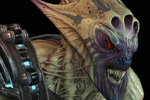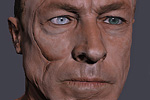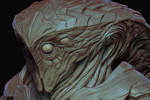Was the texture popping effect that bugged a lot of people in the first game something that was solved through programming, or did it require changes in the graphics themselves?
Jaemus Wurzbach – Lead Character Artist:
The texture pop-in problem was a huge issue in ME1. There was no one easy solution to fix the issue; it was a more of a team effort. For character art in particular in involved us managing our texture resources and material shaders a bit better. The player and party members were given slightly larger texture sizes, whereas the NPC’s you fight or talk with generally have lower res textures. We also tried to limit the amount of textures a character uses to no more than 3, although there are some exceptions. In Unreal we try to share the same materials across a large amount of individual characters and keep them as streamlined as possible while still having them look great. This, in addition to the way that the Level art team built streaming load sections into the levels and the efforts of the programming team helped to significantly minimize the texture pop-in.



Looking back at the first game, what was the one thing that you really thought, "we SO need to change that!"?
Derek Watts – Art Director:
Beyond the performance and pipeline issues, we never really looked at ME 1 and said “my God, that needs to be fixed”. It’s not until you are further into production on the second game that you look back and see all the issues that you should be fixing. Lighting was one of the big jumps we made in ME 2. If you look back at the first game you‘ll see how washed out everything looked compared to ME 2. We needed to bring back the contrast and saturation in the game. That was a key feature we liked in many of the early concepts we had referenced.
Jaemus Wurzbach – Lead Character Artist:
Yeah there were a lot of things that needed an overhaul. Like I said previously, ME1 gave us a great base to start from, but it needed a lot of refinement.
The lighting system needed some love. This was one of the biggest problems we had with ME1; the lighting setup brought in a large amount of ambient light so shadow values would appear very faint. In addition to this we used a post-process effect that added a lot of bloom to the camera. The drawback to this meant that even the smallest amount of specular highlight would blowout to full white. This effectively nullified any effect we would have received from our normal maps. The lighting we did have was also not dynamic and would not interact with your character like you would expect it to. In ME2 the programming and level art team completely revamped the lighting system. The new system was dynamic and would affect your character in a way you would expect it to: when you walk in front of a light, you get brighter. The old post-process effect was also toned down, so the artwork is able to read much better than before.
In ME1 we created a large amount of our assets to be used within a tintable system. This was used on our armors, guns and weapons to help give our designers a large amount of variety to choose from at a cheap cost. This helped them when populating some of the large city areas in the game. The downside to this system is that it makes the artwork look rather bland. Very few things looked unique or stood out as amazing. In ME2 we still use this system for our crowd characters, however we use much more unique assets as well. The blend of these two make the game look much better than before.






